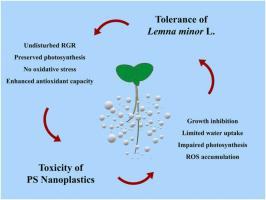Journal of Hazardous Materials ( IF 12.2 ) Pub Date : 2022-07-28 , DOI: 10.1016/j.jhazmat.2022.129692 Busra Arikan 1 , Fatma Nur Alp 1 , Ceyda Ozfidan-Konakci 2 , Evren Yildiztugay 1 , Metin Turan 3 , Halit Cavusoglu 4

|
Plastic pollution, which is currently one of the most striking problems of our time, raises concerns about the dispersal of micro and nano-sized plastic particles in ecosystems and their toxic effects on living organisms. This study was designed to reveal the toxic effects of polystyrene nanoplastic (PS NP) exposure on the freshwater macrophyte Lemna minor. In addition, elucidating the interaction of this aquatic plant, which is used extensively in the phytoremediation of water contaminants and wastewater treatment facilities, with nanoplastics will guide the development of remediation techniques. For this purpose, we examined nanoplastic accumulation, oxidative stress markers, photosynthetic efficiency, antioxidant system activity and phytohormonal changes in L. minor leaves subjected to PS NP stress (P-1, 100 mg L-1; P-2, 200 mg L-1 PS NP). Our results showed no evidence of PS NP-induced oxidative damage in P-1 group plants, although PS NP accumulation reached 56 µg g-1 in the leaves. Also, no significant changes in chlorophyll a fluorescence parameters were observed in this group, indicating unaffected photosynthetic efficiency. PS NP exposure triggered the antioxidant system in L. minor plants and resulted in a 3- and 4.6-fold increase in superoxide dismutase (SOD) activity in the P-1 and P-2 groups. On the other hand, high-dose PS NP treatment resulted in insufficient antioxidant activity in the P-2 group and increased hydrogen peroxide (H2O2) and lipid peroxidation (TBARS contents) by 25 % and 17 % compared to the control plants. Furthermore, PS NP exposure triggered abscisic acid biosynthesis (two-fold in the P-1 and three-fold in the P-2 group), which is also involved in regulating the stress response. In conclusion, L. minor plants tolerated NP accumulation without growth suppression, oxidative stress damage and limitations in photosynthetic capacity and have the potential to be used in remediation studies of NP-contaminated waters.
中文翻译:

纳米塑料毒性对潜在超富集植物 - Lemna minor L 中积累、激素调节和耐受机制的影响。
塑料污染是目前我们这个时代最引人注目的问题之一,它引起了人们对生态系统中微米和纳米塑料颗粒的扩散及其对生物体的毒性影响的担忧。本研究旨在揭示聚苯乙烯纳米塑料 (PS NP) 暴露对淡水大型植物Lemna minor的毒性影响。此外,阐明这种广泛用于水污染物的植物修复和废水处理设施的水生植物与纳米塑料的相互作用将指导修复技术的发展。为此,我们检查了L. minor中的纳米塑料积累、氧化应激标记、光合效率、抗氧化系统活性和植物激素变化叶受到 PS NP 胁迫 (P-1, 100 mg L -1 ; P-2, 200 mg L -1 PS NP)。我们的研究结果表明没有证据表明 P-1 组植物中 PS NP 诱导的氧化损伤,尽管 PS NP在叶子中的积累达到 56 µg g -1 。此外,在该组中未观察到叶绿素a荧光参数的显着变化,表明光合效率未受影响。PS NP 暴露触发了L. minor植物的抗氧化系统,导致 P-1 和 P-2 组的超氧化物歧化酶 (SOD) 活性增加了 3 倍和 4.6 倍。另一方面,高剂量 PS NP 处理导致 P-2 组的抗氧化活性不足,过氧化氢(H 2 O2 ) 和脂质过氧化(TBARS 含量)与对照植物相比分别提高了 25% 和 17%。此外,PS NP 暴露触发脱落酸生物合成(P-1 组为两倍,P-2 组为三倍),这也参与调节应激反应。总之,L. minor植物在没有生长抑制、氧化应激损伤和光合能力限制的情况下耐受 NP 积累,并有可能用于 NP 污染水体的修复研究。











































 京公网安备 11010802027423号
京公网安备 11010802027423号